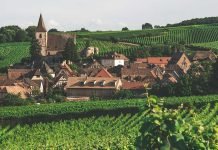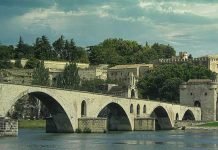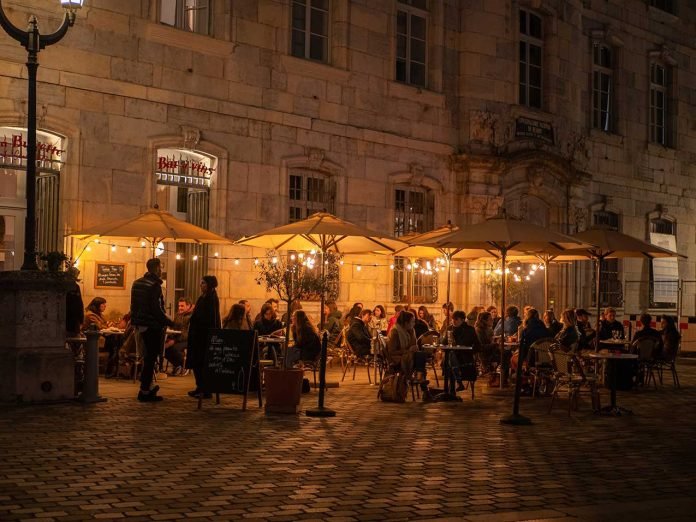Located in the eastern part of France, the Bourgogne-Franche-Comté region is known for its exquisite wines, charming villages, scenic landscapes, and culinary heritage.
- World-renowned Burgundy Wines: The region’s wines, with their robust flavors and elegant bouquets, are celebrated worldwide. The Burgundy wine route, with its centuries-old vineyards, invites visitors on an unforgettable gustatory journey.
- Picturesque Villages: The region is speckled with charming, timeless villages like Noyers and Flavigny-sur-Ozerain, each holding a unique story within their stone-clad walls.
- Rural France Charm: Bourgogne-Franche-Comté embodies the essence of rural France with its rolling farmlands, serene vineyards, and quaint farmhouses.
- Culinary Heritage: The region’s cuisine, defined by dishes like coq au vin and escargot de Bourgogne, and delicacies like comté cheese, is a celebration of its rich culinary traditions.
- Scenic Landscapes: From its sprawling vineyards to its verdant forests, the region is a treat for the senses. Every turn reveals a new, breathtaking view.
- National Parks: The region is home to stunning national parks such as the Morvan Regional Nature Park, offering numerous opportunities for hiking, wildlife spotting, and immersing oneself in nature.
- Historical Sites: Bourgogne-Franche-Comté’s history is etched into its numerous castles, churches, and palaces, like the Château de Châteauneuf and the Dukes’ Palace in Dijon.
- Cultural Institutions: The region’s museums and galleries, such as the Musée des Beaux-Arts de Dijon, offer visitors a window into the area’s rich artistic and cultural heritage.
- Architectural Marvels: The region’s architectural prowess is evident in its buildings, which range from Romanesque churches like the Basilica of Sainte-Marie-Madeleine in Vézelay to Renaissance palaces.
- Natural Wonders: Bourgogne-Franche-Comté is home to numerous natural wonders. The Loue River and the picturesque Baume-les-Messieurs are just two examples of the region’s stunning natural beauty.
History
Bourgogne-Franche-Comté is a region in Eastern France created by the 2014 territorial reform of French regions, from a merger of Burgundy and Franche-Comté.
This land, which once belonged to the Gauls, has been shaped by countless influences throughout the ages, from the Romans to the Dukes of Burgundy. The region is studded with historical landmarks that transport visitors back in time. The Château de Châteauneuf, perched atop the Auxois hill, stands as a formidable testament to the region’s medieval history. The old towns of Besançon and Dijon have been beautifully preserved, offering a journey through history with their cobblestone streets, half-timbered houses, and ancient fortifications.
Romanesque Architecture
The Romanesque architectural marvels of Bourgogne-Franche-Comté are an integral part of the region’s historic and cultural identity. This architectural style, marked by its rounded arches, massive walls, and large towers, came to the fore in medieval Europe and continues to influence contemporary design.
The Abbaye de Cluny was founded in 910 AD, the abbey was once the religious center of Europe and the largest church in Christendom until the construction of St. Peter’s Basilica in Rome. While much of its original structure was destroyed during the French Revolution, the remnants of its grandeur can still be witnessed today, particularly in the surviving transept towers and the cloister. The intricately carved capitals, towering pillars, and the solemn ambience of the ruins continue to invoke awe and wonder among visitors.
The Basilica of Sainte-Marie-Madeleine in Vézelay is another captivating marvel of Romanesque architecture. This UNESCO World Heritage Site was a significant starting point for the pilgrimage to Santiago de Compostela in Spain. Its beautifully sculpted tympanum, depicting the Pentecostal Mission of the Apostles, is a masterpiece of Romanesque art. The basilica’s nave, with its rounded arches and fluted columns, radiates a sense of profound spiritual tranquility.
Major Towns
Dijon: The Epitome of Burgundian Elegance
Dijon, the capital of Bourgogne-Franche-Comté, is a treasure trove of architectural and cultural splendors. Famous for its Dijon mustard, this vibrant city goes beyond gastronomy, offering a rich tapestry of experiences to its visitors.
The city’s most illustrious landmark, the Dukes’ Palace, is home to the Musée des Beaux-Arts, one of the oldest museums in France. The palace itself is a stunning example of Burgundian architecture, and its Philippe le Bon Tower offers panoramic views over Dijon’s terracotta rooftops. The museum’s collection spans from Egyptian antiquities to contemporary art, providing a comprehensive tour of global art history.
The streets of Dijon are an architectural marvel, showcasing well-preserved half-timbered houses, townhouses of the nobility, and distinguished public buildings. The city’s medieval and Renaissance architectural gems, such as the Church of Notre-Dame with its iconic owl sculpture, contribute to Dijon’s captivating old-world charm.
Besançon: A Celebration of Art and History
Besançon, famed as the birthplace of the renowned writer Victor Hugo, is another highlight of the region. Known for its rich history and vibrant cultural scene, Besançon captivates with its beautifully preserved historical architecture and its breathtaking natural surroundings, encircled by the Doubs River.
The city’s most prominent landmark, the Citadel of Besançon, is a UNESCO World Heritage site and an unparalleled example of 17th-century military architecture. Designed by Vauban, Louis XIV’s military engineer, the fortress offers panoramic views of the city and houses several museums, including the Museum of Resistance and Deportation.
Besançon’s historic city center, with its narrow, winding streets, colorful buildings, and charming squares, is a living museum. Its numerous clock towers, reflecting the city’s fame as France’s capital of watchmaking, dot the skyline. The Cathedral of Saint-Jean, with its astronomical clock of 30,000 parts and 70 dials, stands as a testament to this heritage. Each street and square in Besançon offers a slice of history, making it a must-visit destination for those exploring Bourgogne-Franche-Comté.
National Parks and Natural Wonders
The natural splendor of Bourgogne-Franche-Comté is as diverse and impressive as its cultural heritage. From verdant valleys to serene lakes and dramatic cliffs, the region offers numerous natural retreats.
Morvan Regional Nature Park
At the heart of Bourgogne-Franche-Comté lies the Morvan Regional Nature Park, an extensive protected area spanning over 290,000 hectares. This haven of biodiversity is a matrix of deep forests, serene lakes, flowing rivers, and rolling hills. Its varied topography makes it a magnet for outdoor enthusiasts, offering a plethora of activities.
Hiking trails crisscross the park, offering breathtaking panoramic views and the chance to spot wildlife, including deer, wild boars, and a myriad of bird species. The park’s lakes, like the Settons and the Pannecière, are popular spots for fishing and water sports. From mountain biking to horse riding, the Morvan park offers an immersive experience of nature.
The Scenic Wonders of Loue River and Baume-les-Messieurs Village
The Loue River, a tributary of the Doubs, is a gem of the Bourgogne-Franche-Comté region. Originating from a resurgence, it winds through lush valleys and dramatic cliffs, creating an idyllic landscape. Its crystal-clear waters are a paradise for canoeing and fishing enthusiasts.
Nestled in a deep valley where three rivers meet, the picturesque village of Baume-les-Messieurs is another natural marvel of the region. Enclosed by steep limestone cliffs and surrounded by dense forests, the village offers striking scenic beauty. Its caves, considered among the largest in France, are a popular attraction. Visitors can enjoy hiking, climbing, or simply basking in the tranquillity of this enchanting setting.
Food and Wine
Bourgogne-Franche-Comté is a culinary mecca that will delight even the most discerning gastronomes. Its rich agricultural heritage, artisanal craftsmanship, and globally acclaimed vineyards combine to create a flavorful journey that traverses vineyards, farms, and dining tables.
Vineyards of Bourgogne-Franche-Comté: Savoring the Art of Wine
Bourgogne-Franche-Comté’s vineyards are the birthplace of some of the world’s most esteemed wines, including Chablis, Beaujolais, and Côte de Beaune. Walking through these vineyards is like stepping into a living museum of viticulture. Wine enthusiasts will be enthralled by the opportunity to explore the vine-clad slopes, meet the winemakers, and participate in wine-tasting sessions.
The region’s wine heritage is further celebrated in venues like the Burgundy Wine Museum in Beaune, where visitors can delve into the history and intricacies of wine production.
The culinary heritage of Bourgogne-Franche-Comté is deeply rooted in the region’s fertile soils and farming traditions. The regional cuisine is a celebration of simple ingredients transformed into hearty, flavorful dishes. Traditional recipes like the succulent coq au vin, rich beef bourguignon, and the distinctive escargot de Bourgogne provide a delightful taste of the region’s culinary diversity.
The region is also renowned for its exquisite cheeses, with Comté leading the pack. This semi-hard cow’s milk cheese, with its nutty and subtly sweet flavor, is a local favorite and a must-try for any cheese lover.
Cultural Attractions
Bourgogne-Franche-Comté boasts a vibrant cultural landscape, with numerous museums, art galleries, and festivals that showcase the region’s artistic vibrancy and historical significance.
The Musée des Beaux-Arts de Dijon
The Musée des Beaux-Arts de Dijon, housed in the illustrious Dukes’ Palace, is a cultural centerpiece of the region. Its collection spans a broad spectrum of art history, from Egyptian antiquities to modern art, making it a fascinating destination for art lovers. The museum’s medieval and Renaissance collections, in particular, are notable for their comprehensive display of European art from this period.
Beyond the capital, numerous other museums and galleries across the region offer deep insights into local history, culture, and art. From the Museum of Fine Arts and Archeology in Besançon to the Niepce Museum in Chalon-sur-Saône, which pays tribute to the inventor of photography, these cultural institutions provide diverse and enriching experiences.
Bourgogne-Franche-Comté offers an enchanting blend of history, culture, gastronomy, and natural beauty.

















